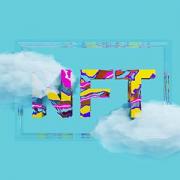BA & SEE EXECUTIVE UPDATE VOL. 22, NO. 9

So, what’s the big deal about NFTs? Companies can utilize them for creating additional revenue streams, developing novel marketplace platforms, and strengthening marketing and branding power. Examples of these have been seen widely in the media and entertainment industries, including movie and music studios, print media, and individual artists. These organizations created and sold NFTs for novel revenue streams, developed NFT marketplaces to facilitate buying and selling, and expanded marketing and branding to new, digital-savvy audiences. As the world continues to shift toward a digital-first culture, digital art in the form of NFTs will become more and more relevant.
The art market at present is highly segregated, for buyers and sellers alike. In terms of gender, for instance, male artists both sell for more and have greater access to auction houses, with about 96% of artwork sold at auctions made by male artists. In addition, a study by City University of New York’s Guttman College found that a staggering 80% of artists in New York City’s acclaimed art galleries are white, and 19% of the US artists represented in that art segment come from one school alone: Yale. These auction houses and galleries not only create a barrier to accessing buyers but simultaneously create another barrier for would-be buyers to engage in art purchases. Thus, it is worth considering if this “art gallery industrial complex” could be toppled by the emergence of NFTs. In other words, do NFTs democratize art?
For blockchain evangelicals and many art collectors, the answer to this democratization question is a resounding yes. Renowned art dealer and collector Kenny Schachter believes that NFTs will dismantle the gatekeeping traditionally held by art dealers and auction houses. Historically, artists have had to work through an established network of dealers, auction houses, and galleries, creating immense barriers to access new and upcoming artists who may not have traditional resources or connections. Today’s upcoming artists can avoid having to work through gallery companies, thus giving them greater power and autonomy to work directly with buyers and curators. Simply putting their work on an exchange website gives them an audience like never before. Pop-culture star turned blockchain icon Paris Hilton neatly synthesizes this on her website, asserting that “anyone can make their voice heard by creating a piece of digital work, and on the flip side, anyone can own one.”
Additionally, NFTs can be fractionalized, holding the potential for a “Robinhood-esque” revolution in the art world. Just as Robinhood allowed new investors into the investing world by offering lower price points for fractional stock shares, NFTs can do the same with art. Multiple owners can hold a stake in a single piece of art, in the same way they might split shares in a stock. All this in sum creates an art world where artists can sell directly to potential buyers without the interference of gatekeeping institutions.
And this isn’t just rhetoric, but rather, reality. Five percent of those making less than US $25,000 a year are invested in NFTs, an equal percentage to those making more than $150,000 annually. The bulk of NFT buyers are, predictably, younger consumers. These are groups that historically have been on the sidelines — looking in on the art world from afar. This reduction in gatekeeping and increased affordability clearly boosts accessibility to art. In turn, we are seeing the empowerment of sellers who would otherwise be outside the upper echelons of art sales and profits.
Empowerment & Accessibility
The “democratization” of art should entail: (1) empowerment of creators; (2) empowerment of art consumers; and (3) accessibility to art, art culture, and taste. In a perfect world, we could view this objectively. Yet, in reviewing this definition of democratization — to empower all creators and consumers and create opportunity in traditionally overlooked, underrepresented, and misunderstood corners of the art world — we realize that there is still a divide between NFTs’ grandiose purpose and what these assets can achieve. Art production, therefore, is not democratized.
We need not look further than the world’s most well-known NFT sale thus far to observe that NFTs have only reinforced traditional social hierarchies in art production and dissemination. Beeple’s sale of “Everydays: The First 5,000 Days” for $69.3 million through auction house Christie’s and the amped-up bidding process that preceded it is an example of the NFT market’s reliance on Christie’s old-world reputation to manufacture value in the art market — the very system that that market decries. And this is not a one-off case: while many of the largest NFT sales have been on new-era platforms like Foundation and Nifty Gateway, they have been sold by the likes of Steve Aoki, Paris Hilton, and James Dorsey, with existing massive followings.
To empower all creators means championing a diverse range of voices. Yet, today, the biggest winners are still white men. A provocative NFT by the anonymous figure “White Male Artist” makes a jab at this. Over the course of each day this past July, White Male Artist canned his own excrement upon consuming the diet of the most financially successful white male artists of the 20th century (e.g., Jeff Koons, Banksy, Andy Warhol). The poop tins, which are bundled with NFTs representing the canned crap, are part of a project appropriately called “$HT COIN.”
Art consumption is not democratized, either, as most NFTs are in the hands of a select few. Recent research from BarabasiLab shows that any two artworks in a network of SuperRare pieces, a platform for buying and selling NFTs, are connected through a chain of no fewer than three collectors. Furthermore, the study tallied 3,210 collectors on SuperRare, finding that the bulk of the artworks were in the hands of just four early investors.
Finally, it’s hard to see how programmable NFTs are adding additional value to the art world. While some startups have given artists new toolkits to create, such as Async Art, which allows artists to build upon each other’s work through layers, according to the Atlantic, the majority “are no more innovative than any random website selling posters.”
What Is Art?
Certainly, the genre of “crypto art” has created new applications and inspirations, such as artist Primavera De Filippi’s creation of the first Plantoid, a “blockchain-based lifeform” that eats cryptocurrencies to pay artists to produce new versions of itself. But we also see instances of NFT art that derive value from the pseudointellectual, smug, and meta debate around “what constitutes art,” such as the sale of an NFT of a single grey pixel for nearly $1.36 million in a Sotheby’s auction. This is a question that harks back to Marcel Duchamp’s anti-art movement and his collection of readymades, a form of artistic expression that has been done many times since. And, by definition, a meta critique of “what is art” must come from artists with established influence, showing that the paradigm-shifting NFTs and their “novel” social critique may only be available to those who already hold power in the old-world hierarchy.
Despite all of this, perhaps the saddest realization to hit the art industry is that most people buying NFTs don’t want them. Those who are buying them are hoping to eventually sell them at a profit down the road. In fact, among reasons reported to CivicScience about purchasing NFTs, the top four were for investment or economic purposes, with art collecting in a lonely fifth place. Thinking about art as a financial asset means we cannot conflate “I do not value this art” with “this art does not have value.” But if no one values an art piece, and yet it is “through the roof” valuable because everyone thinks everyone else values it, does that not fundamentally reflect a misalignment in our system? Why are we putting resources into something no one cares about? Indeed, this purported democratization of art may be vastly diminishing said art’s value. Art is merely becoming another token of wealth, akin to the aforementioned Robinhood stocks, where traders gamble rather than invest based on intrinsic value. For the art industry, this could lead to vast disillusionment with the dream of becoming an artist, tarnishing the artist pipeline for years to come.
Conclusion
It is hard to democratize art when its only perceived value in the NFT realm is scarcity, and when legitimacy is the most important scarce resource. At the same time, perhaps we’re being too harsh on the NFT art scene, with surveys finding that younger and less economically developed people, two groups historically marginalized in the art world, are gaining new access to it. To maintain a strong art NFT market, rather than just a bubble, artists, marketplaces, and buyers alike must reclaim the value of art for what it is — art — rather than purely as a financial play. Then, just as traditional art has become valued aesthetically and financially, NFTs can do the same.
And, although currently limited to works of art, NFTs will continue to become viable revenue streams for companies and will require new resources and capabilities to maximize their effectiveness. Companies such as Disney, Warner Bros, and CNN have already created NFTs to expand revenue streams, enhance their branding, and open the doors for new business models. For example, CNN recently created “The Vault” and began tokenizing famous moments from television broadcasting history, including the space landing and fall of the Berlin Wall. Although the NFTs represent minimal revenue streams, the company’s decision to create an internal NFT marketplace suggests that it may eventually allow others to participate and create a novel business platform. In order to compete in the digital-first world, companies will need to learn from the creativity in the NFT/art community and apply these principles to create effective business strategies for the future.




